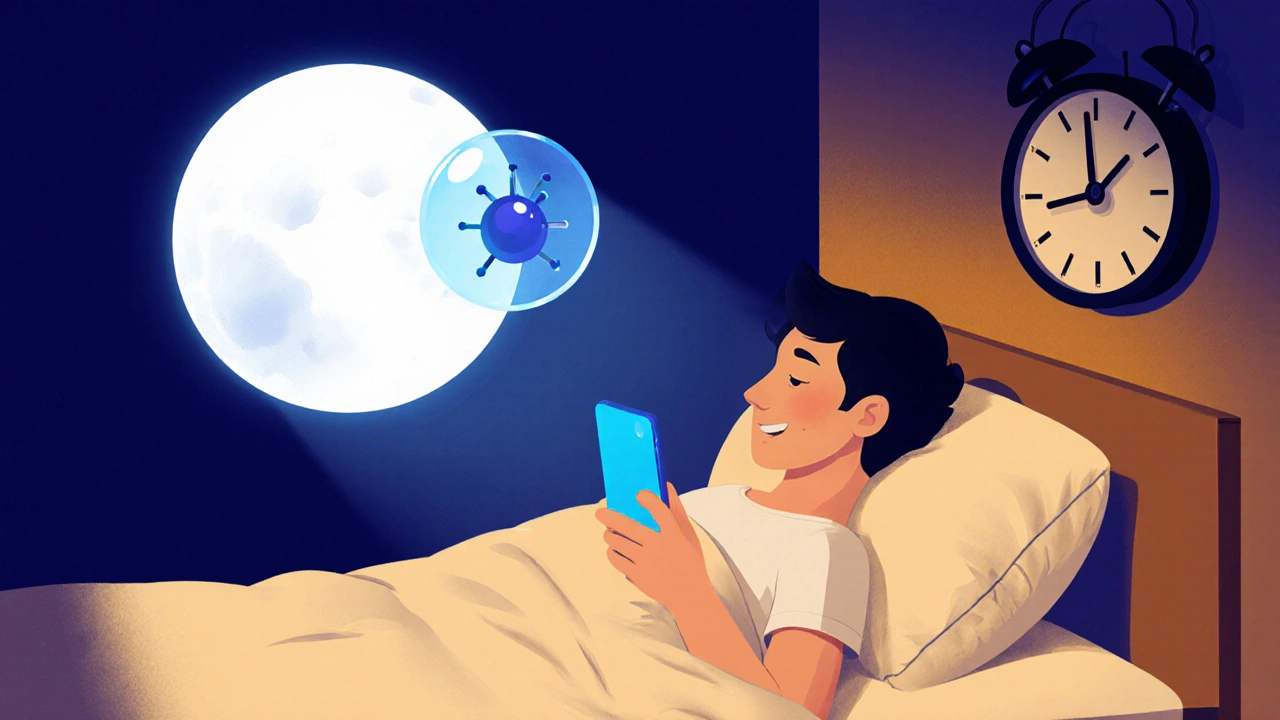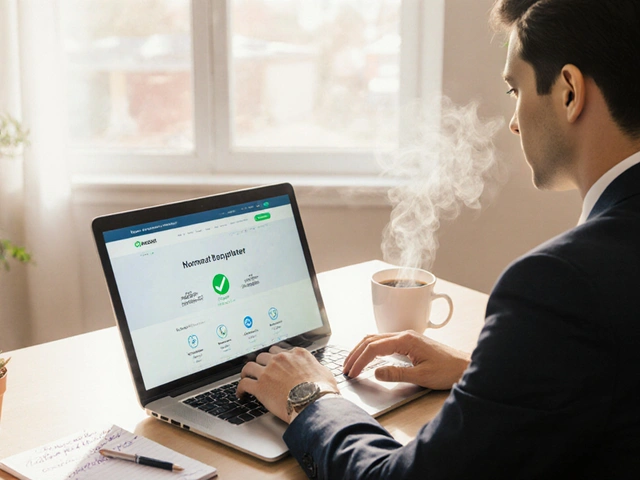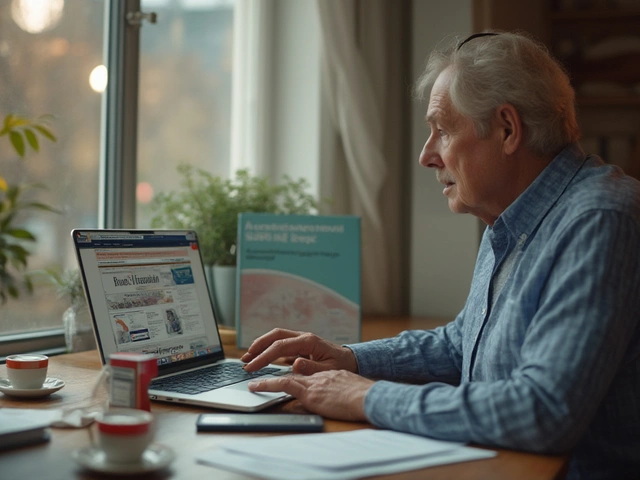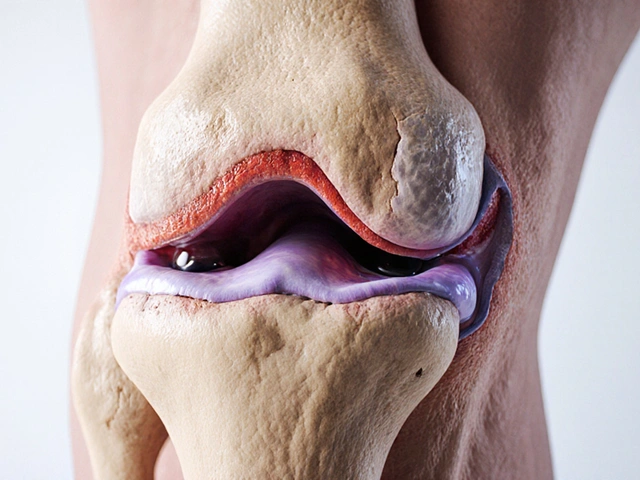Most people know they should put their phones down before bed. But why? It’s not just about scrolling too long-it’s about the blue light hitting your eyes. That glow from your phone, tablet, or laptop isn’t harmless. It’s actively messing with your body’s ability to fall asleep. And it’s happening to millions of us every night, even if we don’t realize it.
What Blue Light Does to Your Brain
Your body runs on a natural clock called the circadian rhythm. It tells you when to wake up, when to feel alert, and when to feel sleepy. At night, your brain releases melatonin-a hormone that makes you drowsy. But blue light, especially the kind emitted by screens, tricks your brain into thinking it’s still daytime. This shuts down melatonin production.
Research from Harvard Medical School in 2012 showed that 6.5 hours of blue light exposure suppressed melatonin for nearly 3 hours-twice as long as green light. Even worse, it shifted your internal clock by 3 hours. That means if you normally fall asleep at 11 p.m., blue light could push that to 2 a.m., even if you’re exhausted.
Not all light is the same. Natural sunlight contains blue light, which is great during the day-it keeps you awake and focused. But artificial blue light from LEDs in screens? That’s the problem. Modern screens emit 30-40% blue light. Incandescent bulbs? Only 15%. And most of us are staring at screens within an hour of bedtime. According to the National Sleep Foundation, 83% of Americans do this.
How Much Screen Time Is Too Much?
The American Academy of Sleep Medicine says: avoid screens for at least one hour before bed. That’s not a suggestion-it’s a clinical recommendation based on solid data. But here’s the truth: one hour isn’t always enough.
A 2022 survey of sleep community users found that those who followed the “90-minute rule”-no screens for 90 minutes before bed-cut their time to fall asleep from over 45 minutes down to under 20. That’s a huge difference. And it’s not magic. It’s biology.
Even if you use night mode or blue light filters, you’re still exposed to light. A study in Scientific Reports (2023) found that using your phone at 30 cm distance for two hours before bed delivers 30-50 lux of blue light. That’s enough to slash melatonin by 50% compared to dim red light. Night Shift or f.lux reduce blue light by about 60%, but they don’t eliminate it. And brightness matters too. If your screen is set to 80% brightness, you’re still flooding your eyes with disruptive light.
The sweet spot? Stop using screens 90 minutes before bed. If that’s too hard, aim for at least 60. And if you must use a device, keep brightness below 50 nits (about 30% of max) and hold it at least 40 cm away from your face.
Do Blue Light Glasses Work?
Blue light-blocking glasses are everywhere now. Amazon has over 2,800 reviews. About 68% of users say they helped them fall asleep faster. But here’s the catch: 22% say they didn’t notice any real change.
Why the mixed results? Because glasses alone aren’t a fix. They help-but only if you’re also turning off other stimulants. If you’re still scrolling through social media or replying to work emails while wearing them, your brain is still wired for alertness. The problem isn’t just the light-it’s the content.
One well-designed study compared blue-light-blocking glasses to placebo clear lenses worn for a week. Those wearing the blue-blocking glasses reported better sleep satisfaction, longer sleep duration, and lower scores on insomnia scales. But another study from the University of Toronto found no difference in melatonin levels between people wearing blue-blocking goggles and those in dim light without them. Why? Because the key factor isn’t just blue light-it’s total light exposure. If your room is bright, even blue-blocking glasses won’t help much.
So, glasses can be useful-but only as part of a bigger plan. Don’t rely on them as your only tool.

What About Screen Filters and Apps?
Most phones now come with built-in tools. iOS has Night Shift and Sleep Focus. Android has Night Light. Third-party apps like f.lux adjust color temperature automatically. These tools are helpful. They reduce blue light by up to 60%, which is better than nothing.
But here’s what most people miss: these features don’t turn off your screen. They just change its color. You’re still looking at a glowing rectangle. Your brain still registers it as active stimulation. And if you’re reading emails, watching videos, or playing games, your mind is still engaged. That mental arousal is just as disruptive as the light.
Apple’s Sleep Focus mode, introduced in iOS 17 (2023), is smarter. It dims the screen, silences notifications, and even suggests relaxing sounds 60 minutes before your scheduled bedtime. That’s the kind of holistic approach that works.
The Bigger Problem: It’s Not Just the Light
Dr. Matthew Walker, a leading sleep scientist at UC Berkeley, put it simply: “Even if blue light effects are partially overstated, the behavioral displacement of screen time-replacing wind-down routines with stimulating content-remains a significant sleep disruptor.”
That’s the real issue. You’re not just absorbing blue light. You’re absorbing stress, drama, news, arguments, and dopamine hits from likes and comments. Your brain goes from calm to alert in seconds. That’s why some people use blue light filters and still can’t sleep.
What you do after putting the phone down matters just as much. Reading a book. Listening to calm music. Stretching. Journaling. These are the real sleep triggers. Blue light is the enemy. But distraction and mental stimulation are its accomplices.

How to Actually Fix This
Here’s what works, based on real data and user results:
- Set a hard screen cutoff. Aim for 90 minutes before bed. If that’s impossible, start with 60. Use a timer if you need to.
- Turn off bright screens. If you must use a device, lower brightness to 30% or less. Keep it at arm’s length.
- Use night mode-but don’t rely on it. Enable Night Shift or f.lux, but don’t use the device for anything stimulating.
- Replace screen time with wind-down rituals. Read a physical book. Take a warm shower. Do 5 minutes of deep breathing. Write down three things you’re grateful for.
- Make your bedroom a screen-free zone. No phones, no tablets, no laptops. Charge them in another room.
- Get daylight in the morning. Exposure to natural light within 30 minutes of waking helps reset your circadian rhythm. Go outside. Open the curtains. Even on cloudy days, it helps.
It takes about 5-6 days on average to form a new habit, according to a University of Glasgow study. That’s all it takes to start seeing results. Don’t expect miracles on day one. But by day five, you’ll notice you fall asleep faster. You’ll wake up less. You’ll feel more rested.
What Experts Say
Dr. Charles Czeisler from Brigham and Women’s Hospital says blue light at night contributes to cancer, diabetes, heart disease, and obesity-not because it directly causes them, but because it disrupts sleep, and poor sleep is a root cause of chronic illness.
The Sleep Foundation, the American Academy of Sleep Medicine, and the National Institutes of Health all agree: limiting evening screen time is a critical part of good sleep hygiene. Even the European Commission, which says evidence isn’t definitive yet, admits that the risk is low enough to warrant caution.
And here’s the kicker: companies are starting to act. Forty-three percent of Fortune 500 companies now have “digital sunset” policies. They encourage employees to log off an hour before bedtime. If corporations are taking this seriously, maybe you should too.
Final Thought: It’s About Control
You don’t need to quit your phone. You don’t need to buy expensive glasses. You just need to take back control of your evenings. Your phone isn’t the enemy. But letting it dictate your sleep schedule? That’s the problem.
Try this tonight: put your phone in another room 90 minutes before bed. Light a candle. Read a page of a book. Breathe. See how you feel in the morning.
That’s not a hack. That’s your body asking for rest. And it’s not asking nicely-it’s begging.
Does blue light really stop you from sleeping?
Yes. Blue light, especially from screens, suppresses melatonin-the hormone that makes you sleepy. Studies show it can delay sleep onset by up to 3 hours and reduce sleep quality. The effect is strongest between 460-480 nanometers, which is the peak range emitted by LED screens.
How long before bed should I stop using screens?
The American Academy of Sleep Medicine recommends at least 1 hour. For better results, aim for 90 minutes. Users who stick to this rule report falling asleep 20-25 minutes faster on average. The key is consistency-not perfection.
Are blue light blocking glasses worth it?
They can help, but they’re not a magic fix. About 68% of users report better sleep, but 22% see no difference. The reason? Glasses only block light-they don’t stop mental stimulation. Use them along with reducing screen time and avoiding stressful content before bed.
Can I use my phone in night mode instead of turning it off?
Night mode reduces blue light by about 60%, which is better than nothing. But you’re still exposing yourself to light and mental stimulation. If you’re reading emails, watching videos, or scrolling social media, your brain stays active. It’s better to turn off the screen entirely 60-90 minutes before bed.
What if I work late and need to use a computer?
Use blue light filters, lower brightness, and keep the screen at least 40 cm away. But also schedule a wind-down ritual after work: take a walk, drink herbal tea, or do light stretching. Avoid work-related thoughts right before bed. Your brain needs to shift from “on” to “off.”
Is blue light the only reason I can’t sleep?
No. Stress, caffeine, irregular sleep schedules, and an uncomfortable bedroom also play big roles. But blue light is one of the most common and easiest to fix. Start here, then address other factors one at a time.
How long does it take to see results after cutting screen time?
Most people notice improvements in 3-5 days. A University of Glasgow study found it took an average of 5.7 days to form the habit of avoiding screens before bed. After that, sleep onset time drops, nighttime awakenings decrease, and morning energy improves.
Do children need to limit blue light too?
Yes-more than adults. Children’s eyes are more sensitive to blue light, and their circadian rhythms are still developing. The NIH has funded a $2.4 million study on blue light’s impact on teen sleep, with results expected in 2025. For now, experts recommend no screens 90 minutes before bed for kids and teens.




Erika Hunt
November 25, 2025 AT 22:40Okay, I’ll be real-I used to think blue light was just a marketing ploy to sell me glasses… until I started actually tracking my sleep with my Apple Watch. I was falling asleep at 1:30 a.m. every night, even when I felt exhausted. Then I tried the 90-minute rule… and holy crap, by day three, I was falling asleep at 11:45 p.m. without even trying. I didn’t buy glasses. I didn’t change my lighting. I just put my phone in the kitchen. And now? I wake up feeling like a human again. Not a zombie. Not a zombie with a coffee IV. A real human. I’m not even kidding. It’s wild how something so simple can feel like a miracle.
Srikanth BH
November 27, 2025 AT 05:33This is such a gentle, grounded post-thank you for writing it. I used to think I was ‘just a night owl,’ but now I see it was just my phone conditioning me. I started leaving my phone in the living room, and I picked up an old paperback. Didn’t even realize how much I missed reading for pleasure. Now I look forward to bedtime. It’s not about avoiding tech-it’s about reclaiming peace. You’ve given me back my nights.
Jennifer Griffith
November 27, 2025 AT 20:50blue light? pfft. i just dont sleep because i’m a hot mess. also my cat sits on my chest at 2am. its not the phone. its my life.
Roscoe Howard
November 28, 2025 AT 21:52It is both alarming and emblematic of the broader cultural decay that so many Americans have surrendered their circadian autonomy to consumer electronics. The data is irrefutable: blue light exposure post-sunset is a biologically engineered form of sleep sabotage, orchestrated by Silicon Valley’s profit-driven design philosophy. The fact that the American Academy of Sleep Medicine must issue clinical guidelines for what should be common sense speaks volumes about the erosion of discipline in modern society. This is not a lifestyle choice-it is a public health crisis.
Kimberley Chronicle
November 30, 2025 AT 12:29From a chronobiology perspective, the 460–480 nm spectral range is the critical band for melanopsin activation in intrinsically photosensitive retinal ganglion cells (ipRGCs)-which directly modulate the suprachiasmatic nucleus. So yes, the mechanism is physiologically validated. But the behavioral displacement component is arguably more impactful: screen-based cognitive arousal (e.g., social comparison, narrative immersion in content) elevates cortisol and dopamine, which independently suppress sleep pressure. Hence, the efficacy of ‘digital sunset’ protocols isn’t just photobiological-it’s neurobehavioral. The 90-minute buffer works because it allows for parasympathetic re-engagement.
Lisa Odence
December 1, 2025 AT 07:35So I tried the 90-minute rule… and guess what? I cried. 😭 Not because I was sad-because I realized I hadn’t sat in silence for more than 10 minutes in 7 years. No notifications. No scrolling. Just me. And a candle. And my thoughts. It was terrifying. And beautiful. I’ve been doing it every night for 11 days now. I don’t need glasses. I don’t need apps. I just need to stop letting my phone be my lullaby. 🌙✨
Patricia McElhinney
December 1, 2025 AT 11:19Everyone’s acting like this is some deep revelation, but it’s basic biology. You’re not ‘busy’-you’re addicted. And you’re lying to yourself about ‘just checking one thing.’ The fact that you need a study to tell you that staring at a glowing rectangle before bed ruins sleep says more about you than the science. Stop blaming blue light. Start taking responsibility. And if you can’t? Then don’t complain when you’re tired, irritable, and overweight. Your phone didn’t make you this way-you did.
Dolapo Eniola
December 2, 2025 AT 08:31Bro, in Nigeria we don’t even have reliable electricity, so we just charge phones at 10pm and sleep with them under our pillows. Blue light? We got spiritual light. 😎🔥 Also, my cousin’s uncle’s daughter said she slept better after burning neem leaves. Science? Nah. Tradition. You all overthink everything. Just turn it off. Or don’t. Your loss.
Agastya Shukla
December 3, 2025 AT 00:01Interesting how the post distinguishes between photic and non-photic disruption. The melatonin suppression data is solid, but the cognitive load from social media is the real silent killer. I’ve noticed that even with blue light filters, if I’m reading comments or DMs, my heart rate stays elevated. It’s not the color-it’s the content. I now use a physical notebook to jot down thoughts before bed. It’s like mental decluttering. Works better than any app.
Pallab Dasgupta
December 4, 2025 AT 18:25Y’all are overcomplicating this. I used to be a zombie at 8am. Then I put my phone in the bathtub at 9pm. No charger. No excuses. I read a book. I drank chamomile tea. I stretched. I didn’t even think about my phone. And now? I wake up before my alarm. I’m not ‘fixing sleep.’ I’m just not letting my phone steal my life anymore. It’s not magic. It’s not science. It’s just… not being a slave. 🙌
giselle kate
December 6, 2025 AT 13:59Blue light is a distraction from the real issue: capitalism has turned rest into a commodity. Your circadian rhythm isn’t broken-your society is. They sell you screens, then sell you sleep aids, then sell you ‘digital wellness’ retreats. The real solution? Burn the algorithm. Delete the apps. Stop participating. But good luck with that-because the system doesn’t want you to sleep. It wants you to scroll until your eyes bleed.
Leisha Haynes
December 8, 2025 AT 11:51Wow I didn’t know I was supposed to be a monk now to get 7 hours of sleep. Next you’ll tell me I need to meditate in a cave while fasting. I’ll take my 60% blue light filter and my 3am TikTok binges thank you very much 😘
Shivam Goel
December 10, 2025 AT 09:44Let’s not forget the confounding variables: caffeine half-life (5–6 hours), evening cortisol spikes due to stress, and bedroom temperature (optimal: 18–19°C). A 2023 meta-analysis in Sleep Medicine Reviews showed that blue light accounts for only 28% of sleep onset latency variance in adults-while stress and caffeine account for 41%. So yes, reduce blue light-but also audit your evening routine holistically. Don’t fixate on one variable. That’s reductionist thinking. And it’s why so many people buy glasses and still can’t sleep.